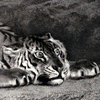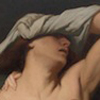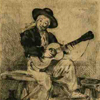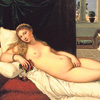The Spanish Singer print was created in 1861-62; the original painting was at the Salon only a year earlier. The painting brought Manet his first major critical success, and because of this success there would have been a demand for an etching for reproductions (Richardson, 1958, 84). However, Manet did not want to leave this job to a professional reproductive editor, but wanted to take on the job himself (Richardson, 1958, 84). In contrast to Olympia and the more uniformed etching (Hyperlink: Figure 3) The Spanish Singer was produced with more of a sketchy overall feel to the print. After establishing the basic outlines of the composition Manet drew more freely, elaborating the effects of the painting (Fisher, 1985, 43). There are areas of the print where the etching is more loose and free, and then areas where there seems to be more control. The areas of control are also the darker areas, and perhaps this is because to create a darker color more control has to be used in overlapping the etching lines (Figure 5). The singer’s jacket is very dark, along with his hat, the top part of the guitar, and the large jar that sits on the ground. Where things are lighter, for example the singer’s pants, the lines are sketchy looking and placed further apart (Figure 6). What is interesting is that in these lighter areas one gets a better sense of movement and expression then in the dark areas, such as the jacket and the hat. One could argue that in the print you can sense the singer’s body movement more than in the painting. (Hyperlink: Figure 8). Shadows also play an important role in this print. In the painting, the shadows are present, but do not catch the viewer’s attention as much as they do in the print.



















